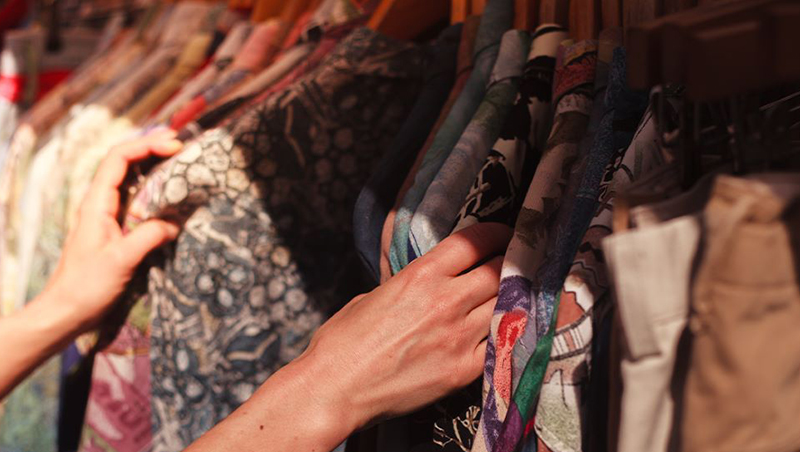Used Clothing or Fast Fashion? Your Buying Habits Matter

It’s so simple. The click of the keyboard loads a website and I see just what I am looking for: exercise leggings in different photo-shopped colors. Scanning the screen for the price, bright red text catches my eye. Nine dollars. Deal. The leggings arrive and I try them on. They don’t hit my ankles and the fabric is slightly see-through, but considering the price, I can’t complain. I am satisfied with my leggings, but I realize too late I could have gotten a similar item for a similar price and higher quality by buying the leggings used. I also would have kept the leggings out of the landfill.
THE TEMPTATION OF FAST FASHION
Shopping for clothes online is tempting when you’re on a budget. The cheap prices and direct shipping are major bonuses, but these bonuses are not worth it when the clothes are poorly made and have detrimental environmental effects. Most cheap clothes sold online are fast fashion—quickly produced items that follow trends. People make fast fashion clothes in poor working conditions and use harsh chemicals and dyes that can irritate the skin, so the final product is cheaper for consumers. Though fast fashion is only cheap for consumers, it accounts for 10% of annual global carbon emissions, according to the World Bank. The fashion industry is also the second-largest consumer of water, and a big player in water pollution, according to Earth Org.
Buying fast fashion supports a throw-away industry. Let’s face it, the clothing you bought from a sketchy online shop is not going to last—it’ll tear, fall apart, and sometimes it is not even wearable when it comes. These clothes often go straight to one place when they’re done: the landfill. According to Common Objective, a business conglomerate for the fashion industry, about 57% of discarded clothes go to the landfill in a year. Clothing is collected as special recycling in parts of Vermont, but low-quality fabric that can’t be turned into rags still goes to the landfill. It’s not worth it to spend money on clothes that will be thrown away within a few months to a year, and it is not environmentally or socially responsible.
USED CLOTHING SAVES MORE THAN MONEY
Buying secondhand clothes is an easy way to cut down on waste production. It diminishes the need for the production of new clothes by keeping things already made in use. This means less waste from manufacturing and less fabric in the landfill. In Vermont, there is only one operating landfill, and in the Northeastern U.S., the landfill space is quickly being used up. Reusing clothing for as long as possible decreases the need for new landfills and is budget-friendly. Secondhand items can even be cheaper in the long run when the quality of secondhand clothes is better than the quality of fast fashion items. Higher-quality items last for years so you can buy fewer items overall. When we consume, we often create waste, so it is our duty as consumers to be responsible with our waste.
You can buy secondhand clothes at thrift shops online and in-person, flea markets, consignment stores, and elsewhere. It’s the same as going to a secondhand market to buy furniture. In wealthier areas, you can even find designer items on the racks for less than 15 dollars. Sometimes secondhand clothes still have tags on them, making the purchase almost like buying it new except it’s inexpensive. I once bought a Gucci purse secondhand for less than 10 dollars, and it turned out to be real! There are hidden gems in the used clothing market for everyone’s style.
Secondhand stores are also a great place to try out outfits that might be out of your comfort zone. I’ve found a lot of pieces I would not normally buy retail because I was able to take a risk on them due to their affordability. The great thing about in-person secondhand shopping is trying an item on for fit. It’s no different than shopping in any other in-person retail store when you go into the dressing room.
Earn competitive rates while funding clean energy loans with a VGreen Money Market account.
Invest in a Greener Future and Save
ONLINE THRIFT STORES MAKES BUYING USED EASY
Online secondhand stores typically provide measurements of the clothes. So, if you want to be a pro at thrifting online, learn what clothing measurements fit you. Take your favorite garments and measure them to compare. This differs from online fast fashion. On fast fashion sites, my friends typically look at reviews of a product to see the fit, as they cannot trust the size chart. At all the secondhand shops I’ve seen online, the measurements are accurate, and I do not have to worry about being scammed.
THESE THRIFTY TIPS WILL HELP YOU SAVE MORE
If I buy something large, or I find a dress I love that is too big, I will alter it. Learning how to sew or take in items can help you customize thrift finds to your liking. Another tip is going to a secondhand shop in the morning immediately after they restock, so you will have the first pick of the clothes there. If you like shopping and want to see everything available, check every section. You will find the buried bargains that were mislabeled or misplaced. If you want more for less, go to the stores on days when there are sales, such as five dollars for a bag of clothes.
Secondhand stores often also sell gently used household items like furniture, school supplies, appliances, kitchen supplies, and more. Some stores heat-treat upholstered furniture to protect from bedbugs, and they test all appliances to make sure they work well before selling them. All these items are much cheaper than they would cost new.
When you’re planning how to spend your budget, there is a clear winner in the choice between fast fashion and used clothes. Secondhand shopping undoubtedly comes out on top as the champ for its’ prices and lesser environmental impact. So, buy used!

You Also Might Like

Planning for Spring Break on a Budget: A Guide for Savvy Travelers

Taxes and Homeownership: Consult a Professional

Debt Snowball vs. Debt Avalanche: Two Ways to Get Out of Debt

Stay informed
Stay up to date on financial tips, tricks, and tools that will build your financial literacy and help you live a more prosperous life.
